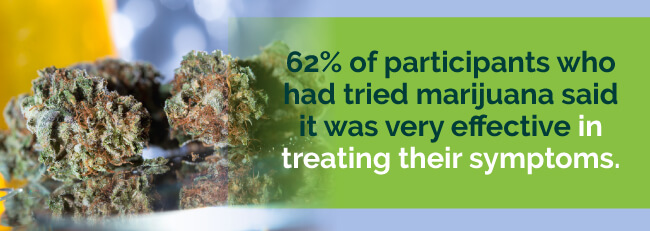
Fibromyalgia causes debilitating pain that is difficult to treat. With no cure for the condition and very few effective traditional treatment options, it’s no surprise that patients may research the effectiveness of medical marijuana for fibromyalgia. Learn more about marijuana and fibromyalgia to determine if it’s a good treatment option for you or a loved one.
Marijuana is known for relieving pain, which lines up perfectly with the primary symptom of fibromyalgia. Traditional pain relievers and other medications prescribed to treat the condition often come up short. For this reason, many patients with the condition turn to the pain-relieving properties of marijuana for fibromyalgia. In the National Pain Foundation survey, 62 percent of participants who had tried marijuana said it was very effective in treating their symptoms and another 33 percent found some relief. Only 5 percent of people who tried it said it provided no relief.
Find A Doctor Find A Dispensary

To understand how weed works to relieve pain, it’s important to understand the body’s endocannabinoid system. The system aids in communicating messages throughout the body. Endocannabinoids tell cells what to do by attaching to receptors in the cells, effectively connecting the brain and various areas of the body. Disruptions in that system can cause pain, sleep issues and other issues.
The cannabinoids in marijuana may fill in for your natural endocannabinoids. This can decrease hypersensitivity to pain, which makes patients with fibromyalgia feel less pain. Medical cannabis may also help with other issues, such as insomnia and nausea, providing even more relief for patients who also suffer from those symptoms. While marijuana can’t cure fibromyalgia, it may be effective in relieving the symptoms so you can live a more normal life.
Since there is no cure for fibromyalgia, effective pain management strategies are essential for helping patients cope with the fibromyalgia. Medical marijuana is very effective in relieving pain, and it is a natural alternative to traditional pain medications often prescribed to fibromyalgia patients.
Many patients turn to cannabis when traditional pain treatments for fibromyalgia fail. Given the poor results from traditional medications, marijuana could be a major factor in relieving fibromyalgia pain. Some people use marijuana as the sole treatment for the pain, while others supplement their current medications and treatments with cannabis.

While fibromyalgia is most notably marked by widespread pain, this disorder is also known to provoke a host of other unwanted symptoms. Patients with fibromyalgia may also experience sleep disruptions, nausea and mood disturbances.
Your ability to access medical marijuana will vary depending on the laws that are present in your state. If you’re interested in exploring cannabis to treat fibromyalgia, it’s best to familiarize yourself with the medical marijuana laws that define your area first.
Often, the first step to becoming a patient is connecting with a state-certified physician. A doctor will have a better understanding of the legal rights that you possess as a fibromyalgia patient. Under their care, you’ll receive a diagnosis that will help serve as a starting point in the enrollment process.
However, diagnosing fibromyalgia can be a little more difficult than some diseases because there is no simple test to run. Another issue is that standard diagnostic testing doesn’t pick up any physiological manifestations of the pain. You can’t do an MRI to see the effects of fibromyalgia or find any indicators of the condition in a blood sample. This lack of physical evidence may cause some physicians to question the validity of the complaints or tell the patient nothing can be done.
Doctors used to diagnose fibromyalgia based on the number of tender points the patient had, but that method is no longer used. Instead, doctors look at the overall symptoms you feel. The diagnosis often comes when the patient reports widespread pain that lasts longer than three months when there is no other underlying condition that might cause the pain. In some cases, the physician may run blood tests to rule out other conditions that could be causing the pain.
Once you receive a diagnosis, your next step will be registering as a fibromyalgia patient in your respective state. Many state laws require that medical marijuana patients sign up for a medical I.D. card that serves as proof of their eligibility.
If you’ve received an official fibromyalgia diagnosis or believe you have this condition, you should connect with a qualified marijuana doctor in your region who can help you enroll as a medical marijuana patient with ease.
Your method of taking marijuana is a matter of personal preference. Smoking marijuana makes the effects happen almost immediately. When you’re feeling the intense pain of fibromyalgia, that fast relief is often a high priority. If you don’t want the potential side effects of smoking marijuana, vaporizing is another option that uses a lower heat point than smoking. Vaping also provides almost instant relief but with less impact on your lungs.
Edibles come in a variety of options, from cookies and ice cream to crackers and nut mixes. Advancements in technology make marijuana edibles more appealing and with more precise dosing than in the past. Edibles take a lot longer to kick in – anywhere from 30 minutes to a few hours. The effects typically last longer, though. For this reason, some people prefer to use edibles at night to ensure the pain relief lasts longer through the night.
Another option that works for treating fibromyalgia is topical application. You get the pain-relieving effects of marijuana without the high. Lotions and oils also let you control application to specific areas of the body where you need the relief most. Some patients use a topical in addition to inhaled or ingested marijuana. Experimenting with strains and with application methods helps you find a treatment routine that is most effective.
You might vaporize an energizing sativa strain during the day to make you alert while relieving pain. At night, you might use an indica strain for sound sleep. Apply topical cannabis products throughout the day as needed for localized relief. Work with your medical marijuana doctor to create an overall marijuana treatment plan that addresses your specific symptoms.
Choosing a strain of marijuana for fibromyalgia depends on your overall symptoms and goals. Here are some considerations when choosing a strain:
Just like finding the best traditional treatments, finding the ideal marijuana strain often comes down to experimenting. You may find that certain strains work during the daytime, while others are better at night. Don’t assume that marijuana doesn’t work on your fibromyalgia after one attempt. You may simply need to try a different strain or use a different method of taking marijuana. A marijuana doctor can look at your specific situation and medical history to help you find a marijuana treatment suited to your needs.
People suffering from fibromyalgia often don’t find satisfactory results from traditional medications, plus they face unpleasant side effects from those medications. While cannabis does have some side effects, they are typically mild and low risk, and the symptoms tend to go away as the effects of marijuana wear off. In many cases, the “side effects” really aren’t negatives, and people with fibromyalgia are happy to deal with them instead of the pain.
Potential side effects of using marijuana to treat fibromyalgia include:
The debate over medical marijuana is often intense, with strong opinions on both sides. While researchers have long been interested in the subject, conducting the actual research is often challenging due to federal regulations and difficulty in accessing the substances to perform the research. Despite the difficulty, research is promising in helping fibromyalgia patients find relief they can’t find with traditional medications.
Research shows that using medical marijuana is an effective way to relieve the pain and anxiety associated with the disease. In 1999, the Institute of Medicine found in their report titled Marijuana and Medicine that the cannabinoids in marijuana can relieve a variety of symptoms, including chronic pain. Additionally, The Journal of Pain reports that patients with fibromyalgia who were treated with a synthetic form of marijuana showed significant reductions in pain and anxiety.
University of Manitoba researchers tested a synthetic cannabinoid called Nabilone on people suffering from fibromyalgia. After four weeks, participants saw a decrease in pain, reduce tender points and lower anxiety. Many people also saw improvement in fatigue, depression, muscle stiffness and overall functioning. These effects are very promising, particularly for people who find little or no relief from traditional treatment options.
If you’re interested in exploring a medical marijuana plan to treat your fibromyalgia, it’s crucial to learn more about your condition and how it impacts your body, first. With a better understanding of this complex pain disorder, you’re in a better position to pursue the medication plan best suited for your needs.
Fibromyalgia is a common condition characterized by long-term, body-wide pain and tender points in joints, muscles, tendons and other soft tissues. The pain comes and goes. Some patients experience pain that migrates or moves around the body.
Fibromyalgia is a complex condition that is not widely understood. Researchers believe pain may be caused by hypersensitivity to stimuli that, under normal circumstances, would not be painful. In other words, the condition occurs when the body doesn’t process pain normally. It affects an estimated 5 million American adults.

The condition has no cure, and the pain can be so severe that it interferes with normal functioning. It is not progressive, meaning you don’t continue to go downhill, and it is not fatal. However, it is very painful. Despite the intense pain, it may be comforting to know that fibromyalgia does not cause any damage to your body in joints, muscles or organs.
Fibromyalgia is often compared to arthritis. While both can cause pain and fatigue, fibromyalgia is not a type of arthritis, as it does not cause inflammation or damage in the joints, muscles and tissue like arthritis does. However, fibromyalgia is considered a rheumatic condition, which essentially means it causes chronic pain that impairs joints and soft tissue.
Fibromyalgia is a complex pain issue that afflicts patients in varying ways. If you have fibromyalgia, your symptoms may vary from those of others living with this condition.
If you’re seeking medical marijuana for fibromyalgia, it’s helpful to understand what type of fibromyalgia you intend to treat. The following is a list of the seven different types of this condition that patients experience most:
The symptoms of fibromyalgia can occur randomly and may afflict different parts of the body over time.
The specific cause of fibromyalgia is unclear, but most experts believe that a wide range of factors contributes to the condition. For example, people may be genetically predisposed to developing fibromyalgia and could be at a higher risk if a family member has it. There are also some illnesses and infections that can either trigger the condition or aggravate it. Certain types of emotional or physical trauma can contribute to fibromyalgia, and it has also been linked to post-traumatic stress disorder (PTSD). Some patients notice symptoms after the initial triggering event, while others slowly notice the symptoms appearing and increasing over time without a specific starting point.
Many experts believe fibromyalgia causes changes in the brain due to repeated stimulation of the nerves. One change, for example, is an abnormal increase in the activity level of neurotransmitters, which are the chemicals in the brain that transport pain signals. Pain receptors in the brain may develop a type of “memory” as a result, overreacting to those pain signals. In other words, fibromyalgia may increase pain sensations based on the way the brain processes those signals.
Certain factors can also increase a person’s risk of developing fibromyalgia. For instance, women are more likely than men to receive a fibromyalgia diagnosis, with 80 to 90 percent of patients being women, according to the National Institute of Arthritis and Musculoskeletal and Skin Diseases. Men and children can get fibromyalgia, but it is much less likely.

Middle adulthood is the most common time when fibromyalgia develops. While you are more likely to develop fibromyalgia if someone else in your family has it, researchers aren’t sure of the exact reason. It could be heredity or similar environmental factors or a combination of both. You may have a higher risk of developing fibromyalgia if you have lupus, rheumatoid arthritis or another type of rheumatic disease. The condition tends to go along with tension headaches, irritable bowel syndrome, temporomandibular joint disorder, depression and anxiety.
Unlike some conditions with outward signs, fibromyalgia symptoms are largely unseen by others, but the patient feels them intensely. Pain is often the symptom associated with the disease. However, many other possible signs accompany the pain and may lead to a fibromyalgia diagnosis. The difficulty lies in the fact that common fibromyalgia symptoms are also common symptoms of other diseases and conditions.
Common symptoms of the condition include:
In addition to the painful and uncomfortable symptoms that come with fibromyalgia, the condition can affect daily life. The pain can make it difficult or impossible to handle regular daily tasks. In some cases, that may include duties required for a job. The fatigue associated with fibromyalgia can interfere with regular activities and work duties. With few options for effective treatment, many people with fibromyalgia continue suffering and dealing with the life disruptions.
Other people who suffer from fibromyalgia also deal with anxiety. This can be from the pain itself and from the misunderstanding that often comes from other people. Patients may have to deal with people saying the pain is all in their heads or that the condition isn’t real. They may face people who think they need to “suck it up.” Colleagues and bosses may be insensitive to the condition. These situations make the fibromyalgia diagnosis even more difficult to deal with.
Fibromyalgia hasn’t always been considered an actual medical condition. While most medical professionals finally believe that fibromyalgia is real, some people still think it isn’t a real medical condition. However, anyone who lives with the pain will tell you it is very real. Despite the very real pain, there aren’t many effective treatments available. Fibromyalgia is difficult to treat, with many patients failing to find effective relief. This is partially due to the lack of understanding of what causes fibromyalgia pain.
Doctors typically recommend several medications to treat fibromyalgia, including pain relievers and antidepressants. The medications come with side effects, and there is no one single drug that addresses all of the symptoms associated with the condition.
Some of the medications used to treat the condition include:
In most instances, doctors will first recommend that patients try over-the-counter pain relievers, such as Tylenol, Advil, Aleve and similar products. If these pain relievers don’t work, the next step is a stronger pain medicine such as Tramadol. Tramadol helps inhibit the action of neurotransmitters and is designed to reduce discomfort, but it is in the class of drugs known as opioids. The medication doesn’t have as high of an addiction risk as other opioids, such as codeine or morphine, but it can still result in serious side effects including nausea, vomiting, dizziness and potentially severe allergic reactions that can lead to swelling of the mouth and face.
Doctors sometimes prescribe an antidepressant such as Cymbalta to help patients sleep. Use of Cymbalta can lead to severe side effects, including panic attacks, hostility, hyperactivity or even suicidal thoughts. Patients sometimes report very stiff muscles, high fever, confusion, unusual bleeding and difficulty urinating. In a survey by the National Pain Foundation, only 8 percent of participants said Cymbalta worked well, while 60 percent said it did not work for them. Another 32 percent found some relief.
In rare instances, a doctor prescribes an anti-seizure drug such as Lyrica to help reduce pain and other discomfort associated with fibromyalgia. Lyrica side effects can include heart and kidney disease, blood disorders, vision problems and swelling of the throat, lips and tongue. The drug has also been linked to swelling in the legs. In extreme instances, the drug can cause a potentially severe allergic reaction. People who have diabetes and take Lyrica need to carefully check their skin on a regular basis and call their doctor if they notice any redness or sores. About 10 percent of people who used Lyrica said it was very effective. Another 29 percent found it somewhat helpful, while 61 percent said it didn’t work at all.
Some fibromyalgia patients use additional therapy methods to complement drug therapy. Some of the common therapies include massage, Pilates, chiropractic care, acupuncture and dietary supplements. Exercise, adequate sleep and generally healthy habits are also recommended lifestyle changes that may help the patient deal with fibromyalgia.
Fibromyalgia is a chronic condition, which means it lasts a long time. Some people do eventually see a gradual decrease in the symptoms, but others suffer the pain indefinitely. With such poor results with the primary drugs prescribed for the condition, it’s clear that something else is necessary to fill those gaps.
Medical marijuana has helped thousands of fibromyalgia patients and it is an affordable, effective and natural alternative to traditional pain medication. If you or someone you love is suffering from fibromyalgia and would like to find out if medical marijuana is the right treatment, we can help.
We can connect you with hundreds of quality marijuana doctors across the country in all legal marijuana states and ensure you are in compliance with your state laws. Book an appointment today and let us help improve your quality of life!
Find A Doctor Find A Dispensary